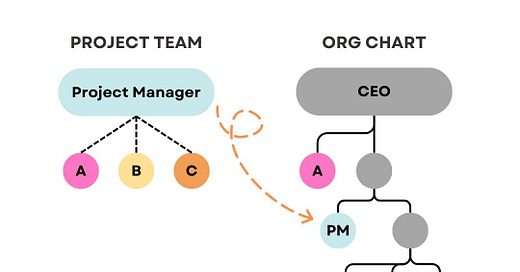Cross-functional collaboration is an essential skill - but is it really two skills?
Project managers face two types of collaboration AT THE SAME TIME:
Cross-functional: Working across teams (e.g. Sales, Marketing, etc.)
Cross-hierarchical: Working across levels (e.g. VP, Analyst, etc.)
You face a unique issue where in the project team you treat people as equals - but in the real world of the company there may be multiple titles between people and power dynamics can AND WILL come into play.
It may be something as seemingly innocuous as the Senior Director of Marketing dictating that meetings can only be on Thursdays to match their timeline - forgetting that Product does “No Meeting Thursdays” and have the project team reports to product.
But who wins in this scenario? And how much do you want to differ from corporate culture and structure in forming your project team?
The Game plan:
How can you run a project with people from different functions AND levels?
Set expectations early
Incentivize desired behavior
Minimize tensions with subgroups
Let’s learn how to collaborate effectively with everyone on your project team!
Set Expectations
A project team is typically a flat reporting structure to encourage the idea that everyone’s input is equal to project success. Even if that structure isn’t mirrored at the organizational level, this is a good time to explain what collaboration looks like on the project team.
Establish a culture of respect by encouraging only productive disagreement. Let teams know in meetings that if they have a disagreement that they will have an opportunity to share their thoughts once the speaker has completed their statement. This allows ideas to be freely shared and debated without someone being talked over.
When it comes to meeting attendance, set the recurring meetings well in advance and if anyone can’t make it let them know that meeting minutes will always be shared so they can stay current with the project. Also provide an option for sharing updates asynchronously by posting to the agenda. This allows team members of all levels to have their time protected and not to deal with constant project meeting time changes if a stakeholder is double booked and wants the meeting to always adhere to their schedule.
Incentivize Success
Project Managers sometimes forget that not everyone enjoys project work all the time. Unlike a project manager, subject matter experts (i.e. everyone else on your project team) have day jobs to do and this project may be the reason they get out of work later than they hoped.
Let them know why, and how, participation will be rewarded, especially across leadership levels.
For senior leaders, encourage meeting attendance by letting them know it will be an opportunity to share senior leadership decision making skills with junior members of the organization. If this isn’t enough of an incentive, senior leaders often have mentorship requirements for promotion criteria and pairing them with a junior team member will allow them to double-dip by having project breakout sessions also count as mentorship sessions.
For junior team members, coach them on presentation skills and time management by running effective meetings and by giving them a chance to present their work at executive review sessions. Sharing a few minutes of the project spotlight with a team member who did the work and can get promoted for it is a huge visibility opportunity.
Divide and Conquer
Not every function gets along - and it isn’t always worth the time to mend the relationship across teams in addition to running the project.
For example, Sales and Marketing typically have a lot of overlapping needs in an organization and it would make sense to group them in project meetings.
But, Sales and Engineering may have tension over a past instance of Sales selling a product that wasn’t complete - thus requiring a lot of scrambling from the engineering team to deliver something they never promised. In this case, having separate feedback sessions with each team to allow them to voice concerns and share unbiased feedback at a group review session may be the best bet.
Dividing and conquering involves more work for the project manager but giving a safe space for each team to air their grievances to the project manager (and not necessarily each other) can help with team unity through the duration of the project.
Morale of the Story
Creating a different team dynamic in your project versus corporate overall is hard.
You are essentially creating a mini-ideal org within a bigger org and that comes with a host of issues - many of which I plan to address in future newsletters - but it’s worth it.
Bringing a project to life with a bunch of eager and motivated people is one of my favorite things in the world. And I want it to be fun for you too.
I hope this helps you as you work on your next project. Let me know in the comments anything you want to learn about projects and making them awesome. Readers like you keep me excited to make these fun Canva diagrams and keep writing =)




